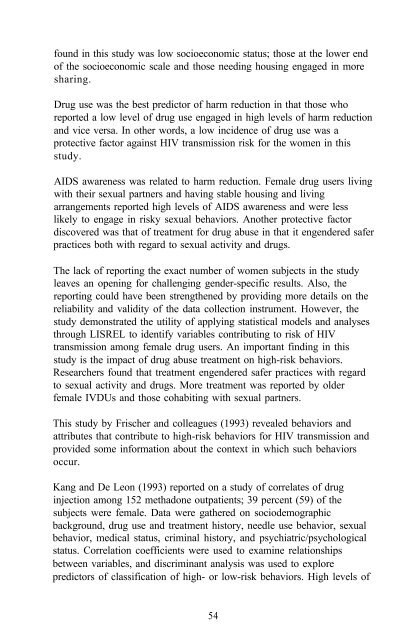The Context of HIV Risk Among Drug Users and Their Sexual Partners
The Context of HIV Risk Among Drug Users and Their Sexual Partners
The Context of HIV Risk Among Drug Users and Their Sexual Partners
Create successful ePaper yourself
Turn your PDF publications into a flip-book with our unique Google optimized e-Paper software.
found in this study was low socioeconomic status; those at the lower end<br />
<strong>of</strong> the socioeconomic scale <strong>and</strong> those needing housing engaged in more<br />
sharing.<br />
<strong>Drug</strong> use was the best predictor <strong>of</strong> harm reduction in that those who<br />
reported a low level <strong>of</strong> drug use engaged in high levels <strong>of</strong> harm reduction<br />
<strong>and</strong> vice versa. In other words, a low incidence <strong>of</strong> drug use was a<br />
protective factor against <strong>HIV</strong> transmission risk for the women in this<br />
study.<br />
AIDS awareness was related to harm reduction. Female drug users living<br />
with their sexual partners <strong>and</strong> having stable housing <strong>and</strong> living<br />
arrangements reported high levels <strong>of</strong> AIDS awareness <strong>and</strong> were less<br />
likely to engage in risky sexual behaviors. Another protective factor<br />
discovered was that <strong>of</strong> treatment for drug abuse in that it engendered safer<br />
practices both with regard to sexual activity <strong>and</strong> drugs.<br />
<strong>The</strong> lack <strong>of</strong> reporting the exact number <strong>of</strong> women subjects in the study<br />
leaves an opening for challenging gender-specific results. Also, the<br />
reporting could have been strengthened by providing more details on the<br />
reliability <strong>and</strong> validity <strong>of</strong> the data collection instrument. However, the<br />
study demonstrated the utility <strong>of</strong> applying statistical models <strong>and</strong> analyses<br />
through LISREL to identify variables contributing to risk <strong>of</strong> <strong>HIV</strong><br />
transmission among female drug users. An important finding in this<br />
study is the impact <strong>of</strong> drug abuse treatment on high-risk behaviors.<br />
Researchers found that treatment engendered safer practices with regard<br />
to sexual activity <strong>and</strong> drugs. More treatment was reported by older<br />
female IVDUs <strong>and</strong> those cohabiting with sexual partners.<br />
This study by Frischer <strong>and</strong> colleagues (1993) revealed behaviors <strong>and</strong><br />
attributes that contribute to high-risk behaviors for <strong>HIV</strong> transmission <strong>and</strong><br />
provided some information about the context in which such behaviors<br />
occur.<br />
Kang <strong>and</strong> De Leon (1993) reported on a study <strong>of</strong> correlates <strong>of</strong> drug<br />
injection among 152 methadone outpatients; 39 percent (59) <strong>of</strong> the<br />
subjects were female. Data were gathered on sociodemographic<br />
background, drug use <strong>and</strong> treatment history, needle use behavior, sexual<br />
behavior, medical status, criminal history, <strong>and</strong> psychiatric/psychological<br />
status. Correlation coefficients were used to examine relationships<br />
between variables, <strong>and</strong> discriminant analysis was used to explore<br />
predictors <strong>of</strong> classification <strong>of</strong> high- or low-risk behaviors. High levels <strong>of</strong><br />
54
















